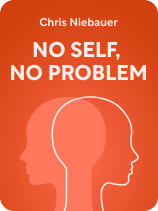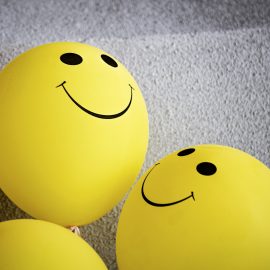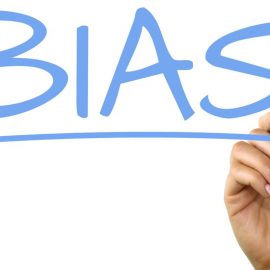

This article is an excerpt from the Shortform book guide to "No Self, No Problem" by Chris Niebauer. Shortform has the world's best summaries and analyses of books you should be reading.
Like this article? Sign up for a free trial here.
Do you understand what the right brain does? Have you ever wondered why some experiences feel more intuitive than others?
In his book, No Self, No Problem, neuroscientist Chris Niebauer explores the fascinating world of brain hemispheres. He explains how the right brain perceives reality differently from the left, focusing on its ability to live in the present moment and process information holistically.
Read on to discover what the right brain does and how it shapes our experiences.
The Right Brain Lives in the Present Moment
While the left brain is constantly talking to itself—judging, sequencing, categorizing, and labeling everything we experience—the right brain approaches reality differently. Niebauer explains what the right brain does: it experiences the world without the constraints of language because, while it understands language, it can’t produce language. Instead, the right half of your brain perceives the world more directly, without the filter of the left half’s narratives. (Shortform note: Experts say that, when the right brain participates in processing or understanding language, it tends to focus on the emotional signals in language, versus the sounds and syntax the left brain focuses on.)
(Shortform note: Niebauer says that, most of the time, the language center—the area of the brain that produces language—is located in the left brain, which leaves the right brain unable to produce language. This is true for an estimated 97% of people. But there are exceptions: A few people who are left-handed have language regions in the right hemisphere, and many people who are left-handed have some language capabilities on both sides of their brain.)
Niebauer explains that the right brain and the left brain are constantly sharing what they’re learning and doing. The left brain does this in words, which gives you the ability to consciously think about what you’re doing. But Niebauer notes that, because the right brain can’t “speak” to the left brain in words, it leaves the left brain in the dark as to what it’s doing. So the left brain labels many of the activities of the nonverbal right brain “unconscious,” even ones that involve choice and complex thinking.
For example, if you decide to stand up and walk across the room, you have very little insight into how your brain makes it happen. The process feels unconscious because your right brain doesn’t narrate what it’s doing. Instead, it acts in the present, without explaining itself in a way that tells your left brain (and thus “you”) what’s happening behind the curtain.
(Shortform note: It’s not all bad news when you dig into the details of how the left brain and right brain communicate with each other. Psychologists say one of the interesting ways that the two hemispheres coordinate information involves a process that’s a bit like ping pong. Just as you and the player on the other side of the ping pong table fall into a rhythm—getting faster and more precise as you pass the ball back and forth—the sides of the brain also get better at passing information back and forth when you’re moving more quickly and need to make quicker decisions. Counterintuitively, the process is also particularly fast during rapid eye movement (REM) sleep—as if your left brain and right brain are playing ping pong while you sleep.)
While the right brain’s ability to think and act without language creates some odd effects in its collaboration with the left, it comes with benefits, too. Niebauer explains that the right brain’s ability to think without the constraints of verbal language gives us several kinds of nonverbal knowledge: intuition, emotions, plus a more holistic way of making sense of the world than the narrative-based method of the left brain.
(Shortform note: Scientists say we never stop thinking, but we don’t have conscious access to many of the thoughts and decisions our brains produce. As Niebauer suggests, that may be because many processes in the brain happen independent of language. We can do things like access memories, make plans for the future, reason about how to behave in social encounters, make moral decisions, feel intuition, and understand emotions without using the brain’s language system. But how? The Mind Is Flat author Nick Chater explains though language gives us a way to communicate—to ourselves or others—the conclusions of our thinking, it doesn’t contain the thinking itself. Thoughts come first, and language comes second.)
Intuition and Emotions
Our decisions are often influenced by nonverbal knowledge that comes from the right brain. That includes the kind of nonverbal knowledge we call “intuition.” As Niebauer explains it, intuition feels like having knowledge about something but not being able to articulate where this knowledge came from. That’s exactly how our intuitions come about: When the right brain sends information to the left, the left brain can’t place where it came from. So it calls it an intuition.
(Shortform note: You can understand intuition as a process where your brain uses your past experiences, along with information about your present situation, to inform your decisions. Niebauer identifies pattern recognition primarily with the left brain. But Switch Craft author and psychologist Elaine Fox writes that intuition, which is associated with the right brain, also relies on pattern recognition. She explains intuition arises from your brain’s ability to analyze patterns and probabilities before you consciously catch up. Intuitions are predictions about how what you’re currently experiencing matches up with what you’ve seen in the past. They can guide you toward better decisions when you use them alongside more rational kinds of decision-making.)
Intuition plays an important role in our emotions, which are also associated with the right brain, according to Niebauer. One emotion in particular—gratitude—both illustrates how the right brain sees the world and explains how the right brain’s way of seeing the world can dissipate the illusion of the self. Niebauer explains we feel something like the opposite of gratitude when we judge our experiences. The left brain labels them “good” or “bad,” and when we hold onto these judgments, they reinforce the illusion that we’re a separate “self” interacting with the world. But when we practice gratitude, the right brain takes over and we can accept reality as it is, without judging it, and appreciate what we experience in the present moment.
(Shortform note: There might be something to the popular advice to create a gratitude journal or find another way to remind yourself what you’re grateful for each day: Experts say your mental health depends less on what you experience, in objective terms, and more on what you choose to pay attention to. Neuroscientist Alex Korb, author of The Upward Spiral, says that practicing gratitude boosts your mental health by teaching your brain what to pay attention to. By acting on brain circuits related to mood, motivation, and resilience, gratitude helps your brain learn that finding the good in an experience is important—and that there’s value in learning to accept reality as it is, without the labels and judgments that shore up your sense of self.)
Seeing Things as Connected, Rather Than Separate
Niebauer explains that the right brain takes a holistic view of the world, enabled in part by emotions like compassion. Buddhists understand compassion as an ability to see how everyone is connected. So it’s no surprise that while your left brain considers you an individual separate from everyone else, the compassionate right brain can see everything and everyone as interconnected, rather than as separate entities.
(Shortform note: Buddhists explain that to their way of thinking, compassion comes from realizing you’re part of a larger whole and you and everyone else are interdependent. The concept extends beyond humans to suggest that all of life is interconnected. One way to think about this is to consider the people in your community, whom you can see not only as people sharing ideas and experiences but also as bodies interacting with each other. As essayist Eula Biss explores in On Immunity, a book about vaccination, the interdependence of our lives makes us vulnerable, whether to infectious disease or infectious ideas. But it also leaves us open to profound possibilities for connection and solidarity, two very right-brain experiences.)
The right brain’s ability to see connections means that while the left brain sees everything you experience as a series of separate events and focuses on specific observations or perceptions, the right brain views things holistically. Niebauer explains that the right half of your brain treats experiences and pieces of information as if they’re all connected to one another and develops comprehensive impressions rather than thoughts or judgments pinned to specific pieces of information.
(Shortform note: The idea that the right brain processes information holistically was first proposed by Roger Sperry, one of the researchers whose studies with split-brain patients Niebauer cites. Sperry’s experiments in the 1950s and 1960s showed the left brain to be analytical, rational, and verbal, and the right brain to be conceptual, holistic, and intuitive. Deep Knowing author Kim Hermanson says scientists still haven’t fully developed the ideas Sperry proposed. She explains that we tend to dismiss the capabilities of the right brain in favor of the skills of the left. But we need our right brains to feel connected to ourselves, to each other, and to the Earth—as well as to practice creative thinking that isn’t accessible to the left brain.)

———End of Preview———
Like what you just read? Read the rest of the world's best book summary and analysis of Chris Niebauer's "No Self, No Problem" at Shortform.
Here's what you'll find in our full No Self, No Problem summary:
- Why everything you know about yourself is wrong
- How science is catching on to what Eastern religions have been teaching for millenia
- How to loosen your grip on the thoughts and judgments that make you dissatisfied with your reality






